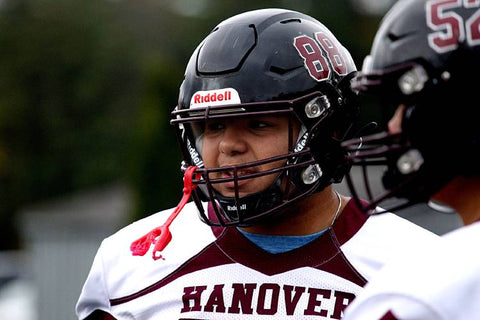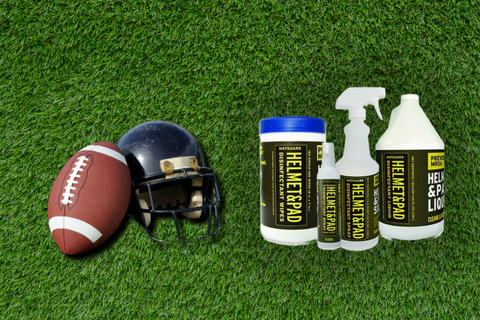
Rash from Football Chin Strap: Best Strategies to Prevent
Brief Overview of the Common Issue of Rashes Caused by Football Chin Straps
A rash from a football chin strap is a frequent concern among athletes, stemming from the continuous wear of protective gear during games and practices. This type of rash, often characterized by redness, irritation, and sometimes infection, occurs where the chin strap contacts the skin. Given the physical nature of football, the combination of sweat, dirt, and constant friction can create an ideal environment for skin irritation and the development of rashes.
Importance of Addressing This Issue for Comfort and Health While Playing Football
Ignoring a rash from a football chin strap not only affects an athlete's comfort but can also have broader implications for their health and performance on the field. Skin irritation that seems minor at first can quickly escalate into more severe conditions, such as infections if left unaddressed. Furthermore, discomfort from a rash can distract players from focusing on their game, potentially affecting their performance and enjoyment of the sport. Addressing this issue promptly ensures players can continue to participate in football activities comfortably and safely.
Understanding Chin Strap Rashes
Explanation of What a Chin Strap Rash Is and Why It Occurs
A chin strap rash is an irritation of the skin that occurs under the chin strap of a football helmet. This irritation can manifest as redness, bumps, itching, or even blistering. The primary cause of these rashes is the combination of moisture from sweat, heat, and friction generated by the chin strap against the skin during intense physical activity. These factors disrupt the natural barrier of the skin, leading to irritation and, in some cases, bacterial or fungal infections.
Factors Contributing to the Development of Rashes
Several key factors contribute to the development of a rash from a football chin strap:
- Sweating: Intense physical activity leads to sweating, which adds moisture under the chin strap, softening the skin and making it more susceptible to irritation.
- Friction: The constant rubbing of the chin strap against the skin can cause micro-tears, allowing bacteria to enter and leading to inflammation and rash.
- Bacteria Buildup: Helmets and chin straps are often used without proper cleaning, allowing bacteria and fungi to accumulate and thrive in the warm, moist environment under the chin strap.
The Importance of Preventing Chin Strap Rashes
The consequences of neglecting a rash from a football chin strap extend beyond mere discomfort. In severe cases, the skin can become infected, requiring medical intervention. Such infections not only sideline players but can also lead to more serious health issues if the infection spreads. Additionally, the discomfort from a rash can significantly detract from an athlete's focus and performance, hindering their ability to play effectively.
Preventing these rashes is crucial not only for the player's immediate comfort but also for their overall skin health and hygiene. By adopting preventive measures, players can protect their skin, maintain their performance, and enjoy the game without the added worry of skin irritation or infection.
Rash from Football Chin Strap: Best Strategies for Prevention
Choose the Right Chin Strap
- Importance of Selecting a Chin Strap Made from Hypoallergenic Materials: Choosing a chin strap that is made from hypoallergenic materials is crucial to minimize the risk of allergic reactions and skin irritation. Hypoallergenic materials are less likely to cause a rash from a football chin strap, as they are designed to be gentle on sensitive skin.
- Recommendations for Breathable and Moisture-Wicking Options: Opt for chin straps that offer breathable and moisture-wicking properties. These materials help in managing sweat, keeping the skin dry, and reducing the likelihood of rash development. Breathable fabrics allow air circulation, while moisture-wicking materials draw sweat away from the skin, preventing the moist environment that bacteria thrive in.
Proper Fitting

- Guide on How to Ensure the Chin Strap Fits Correctly: A properly fitting chin strap is essential to prevent excessive movement and friction against the skin. Ensure that the chin strap is snug but not overly tight, as it should secure the helmet without causing discomfort. Adjust the strap according to the manufacturer's instructions for a fit that minimizes movement and reduces the risk of skin irritation.
Maintain Hygiene

- Tips for Regular Cleaning of the Chin Strap: Regularly clean the chin strap to remove sweat, bacteria, and dirt. After each use, wipe down the chin strap with a damp cloth and mild soap. Allow it to air dry completely before the next use.
- Suggestions for Disinfecting Methods and Safe Cleaning Products: Use disinfectant sprays and wipes, such as Matguard's disinfectant spray, to thoroughly clean all football equipment, including the chin strap. Matguard's disinfectant wipes are also effective for quick cleanups before and after each game or practice, helping to keep the equipment sanitized and reduce the risk of skin infections.
Use Barrier Methods
- Advice on Using Protective Barriers: Applying petroleum jelly or barrier creams to sensitive areas of the skin can help protect against friction and irritation from the chin strap. These products create a protective layer that minimizes direct contact and reduces the risk of rash development.
- Options for Wearing a Thin, Clean Cloth or Liner Under the Chin Strap: Consider wearing a thin, clean cloth or liner under the chin strap as an additional protective barrier. This can absorb sweat and reduce friction, further preventing the occurrence of rashes.
Skin Care Routine
- Recommendations for a Pre- and Post-Game Skin Care Routine: Establish a skin care routine that includes cleansing, moisturizing, and applying anti-inflammatory or antibacterial products as needed. Before and after each game or practice, use Matguard's antibacterial body wipes on your face and body to clean the skin and remove bacteria, reducing the chance of rash development.
- Importance of Moisturizing: Moisturizing helps maintain the skin's natural barrier, making it more resilient against irritation. Look for moisturizers that are suitable for sensitive skin and free from irritants.
Stay Hydrated and Nutrition
Discussion on the Role of Hydration and Nutrition in Maintaining Skin Health: Adequate hydration and a balanced diet play a crucial role in skin health. Drinking plenty of water helps maintain the skin's elasticity and resilience, while a nutritious diet rich in vitamins and minerals supports skin repair and regeneration. Together, hydration and nutrition can significantly reduce the risk of developing a rash from a football chin strap.
Rash from Football Chin Strap: When to Seek Medical Attention and Conclusion
When to See a Doctor
Experiencing a rash from a football chin strap is common among players, but it's crucial to recognize when this issue requires medical attention. If you observe any of the following signs of infection or severe skin reactions, it's time to consult a healthcare professional:
- Persistent Rash: If the rash does not improve with preventive measures or worsens over time.
- Signs of Infection: Look for symptoms such as increased redness, swelling, warmth, pus, or if the rash becomes painful to touch. Fever accompanying a rash is also a sign that the body is fighting an infection.
- Severe Skin Reactions: Symptoms such as blistering, extensive peeling, or the development of open wounds in the area affected by the chin strap indicate a severe reaction that needs medical evaluation.
- Allergic Reactions: If you suspect the rash may be due to an allergic reaction to the material of the chin strap, characterized by intense itching or the spread of rash beyond the area of contact.
Promptly addressing these symptoms can prevent more serious health issues and ensure a quicker return to the field.
The rash from a football chin strap, while a common issue, can significantly impact a player's comfort, health, and performance. The strategies discussed in this blog post—choosing the right chin strap, ensuring proper fitting, maintaining hygiene, using barrier methods, following a skincare routine, and focusing on hydration and nutrition—are effective ways to prevent these rashes. By implementing these preventive measures, players can protect their skin from irritation and infection, allowing them to focus on their performance and enjoy the game to its fullest.
Conclusion
We encourage all football players to adopt these practices. Not only do they contribute to your overall skin health, but they also enhance your experience on the field. Remember, taking care of your skin is just as important as honing your skills in the game. By paying attention to both, you ensure that nothing holds you back from achieving your best performance. Stay vigilant about your skin's condition, and don't hesitate to seek medical advice when necessary to keep skin issues like rashes from sidelining you from the sport you love.
FAQ: Common Football Equipment Rashes and Prevention
Q1: What causes thigh rash from football pads?
A1: Thigh rash from football pads is often caused by friction, sweating, and bacteria buildup between the skin and pads during intense activity. The combination of moisture and repetitive motion can irritate the skin, leading to rashes.
Q2: How can I prevent rash from football girdle?
A2: To prevent rash from a football girdle, ensure it fits properly without being too tight, choose materials that wick away moisture, and maintain good hygiene by regularly washing the girdle. Using a barrier cream or powder can also help minimize friction and moisture.
Q3: Why do I get a rash from football shoulder pads?
A3: Rashes from football shoulder pads can occur due to a combination of factors, including friction from movement, trapped sweat, and dirt, leading to skin irritation. Wearing a breathable, moisture-wicking undershirt and ensuring the pads fit correctly can help reduce the risk.
Q4: What are general tips for preventing rashes caused by football equipment?
A4: General tips include:
- Keeping the equipment clean and dry.
- Using moisture-wicking undergarments.
- Applying barrier creams or powders to sensitive areas.
- Ensuring all equipment fits properly to reduce unnecessary friction.
- Showering and changing into clean clothes immediately after play.




